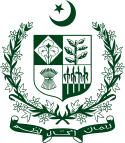List of prime ministers of Pakistan
- Top left: Liaquat Ali Khan was the first prime minister of Pakistan since its inception.
- Top center: Zulfikar Ali Bhutto was the first prime minister to have been democratically elected as he was in 1977.
- Top right: Benazir Bhutto was Pakistan's first and only female prime minister.
- Bottom left: Nawaz Sharif is the longest serving non-consecutive prime minister, having served a total of 9 years in his 3 incomplete terms.
- Bottom center: Imran Khan was the country's 22nd[lower-alpha 1] prime minister and is recognized as a popular global figure.
- Bottom right: Shehbaz Sharif is the incumbent prime minister of Pakistan.
 |
|---|
| This article is part of a series on the politics and government of Pakistan |
The Prime Minister of Pakistan serves as the head of the Government of Pakistan. The Prime Minister is responsible for managing the administration through an appointed federal cabinet and is tasked with formulating national and foreign policies to protect the interests of the nation and its citizens. This is done in collaboration with the Council of Common Interests. Additionally, the Prime Minister has the authority to decide when to call nationwide general elections for the bicameral Parliament of Pakistan.
Since 1947, Pakistan has had 20 prime ministers, excluding the caretaker prime ministers who were appointed solely to oversee the government until elections were completed. In Pakistan's parliamentary system, the prime minister is sworn in by the president and is typically the chairman or president of the party or coalition that holds a majority in the National Assembly, the lower house of Parliament.
Following the partition of India on the midnight of 14/15 August 1947, Pakistan adopted a system similar to that of Britain, establishing the role of prime minister based at the Prime Minister's Secretariat. The first governor-general of Pakistan, Muhammad Ali Jinnah, sought counsel from the Founding Fathers and appointed Liaquat Ali Khan to lead his administration on 15 August 1947. Between 1947 and the imposition of martial law in 1958, seven prime ministers served before the presidential system was introduced in 1960.
The office of the prime minister was briefly revived in 1971 but was suspended shortly thereafter. Executive powers and authority were granted to the prime minister with the promulgation of the full Constitution of Pakistan in 1973; however, the position was effectively rendered inactive following another martial law in 1977. After the general elections in 1985, the office was reinstated. From 1985 to 1997, executive powers were shared between the president and the prime minister due to the 8th Amendment to the Constitution. In 1997, the 13th Amendment was passed, restoring full executive powers to the prime minister. Between 1988 and 1999, the office was held by Benazir Bhutto of the Pakistan People's Party and Nawaz Sharif of the Pakistan Muslim League (N), each serving two non-consecutive terms: Bhutto from 1988 to 1990 and again from 1993 to 1996, and Sharif from 1990 to 1993 and then from 1997 to 1999.
Key[edit]
| Party name | |
|---|---|
Notes[edit]
- ↑ Excluding caretaker Prime Minister's, Khan was the 19th Prime Minister.







